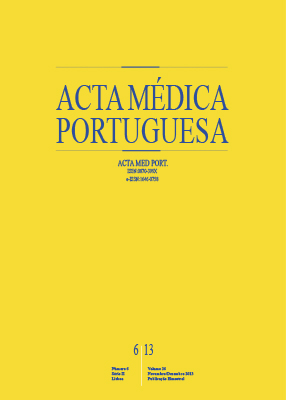Indications for Cesarean Deliveries during a 7-Year Period in a Tertiary Hospital
DOI:
https://doi.org/10.20344/amp.2001Abstract
Introduction: To analyze the cesarean section rate evolution in a tertiary hospital and the main indications for cesarean section.Material and Methods: A retrospective study was conducted at a major academic hospital and included 5 751 women who had a cesarean section from 2005 to 2011. The rates of overall, primary and repeat cesarean sections were analyzed. A linear regression and adjusted R-square were used to access the relative contribution of each indication to the variation in primary cesarean section.
Results: During the 7-year period of the study the cesarean section rate decreased from 30.9% to 27.6%. This was due to a decrease in primary cesarean section (21.9% to 18.2%), although an increase in repeat cesarean section was observed (9.0% to 9.4%). Among the indications for primary cesarean section, maternal-fetal indications and malpresentation were the ones that decreased the most with adjusted R-square of 0.70 and 0.55, respectively.
Discussion: The collected data identified that the decrease in the cesarean section rate at the hospital resulted from a decrease in primary cesarean section deliveries, especially the ones performed for maternal-fetal indications and malpresentation.
Conclusion: The decrease in primary cesarean section rate may be attributed to several changes in medical policies in the Department, such as the implementation of an external fetal version program, the induction of labor only after the 41st week of gestation in low-risk pregnancies and the trial for vaginal birth in maternal-fetal disease. Nevertheless subjective indications such as labor arrest disorders and nonreassuring fetal heart rate are still major contributors for primary cesarean section rate.
Downloads
Downloads
Published
How to Cite
Issue
Section
License
All the articles published in the AMP are open access and comply with the requirements of funding agencies or academic institutions. The AMP is governed by the terms of the Creative Commons ‘Attribution – Non-Commercial Use - (CC-BY-NC)’ license, regarding the use by third parties.
It is the author’s responsibility to obtain approval for the reproduction of figures, tables, etc. from other publications.
Upon acceptance of an article for publication, the authors will be asked to complete the ICMJE “Copyright Liability and Copyright Sharing Statement “(http://www.actamedicaportuguesa.com/info/AMP-NormasPublicacao.pdf) and the “Declaration of Potential Conflicts of Interest” (http:// www.icmje.org/conflicts-of-interest). An e-mail will be sent to the corresponding author to acknowledge receipt of the manuscript.
After publication, the authors are authorised to make their articles available in repositories of their institutions of origin, as long as they always mention where they were published and according to the Creative Commons license.









